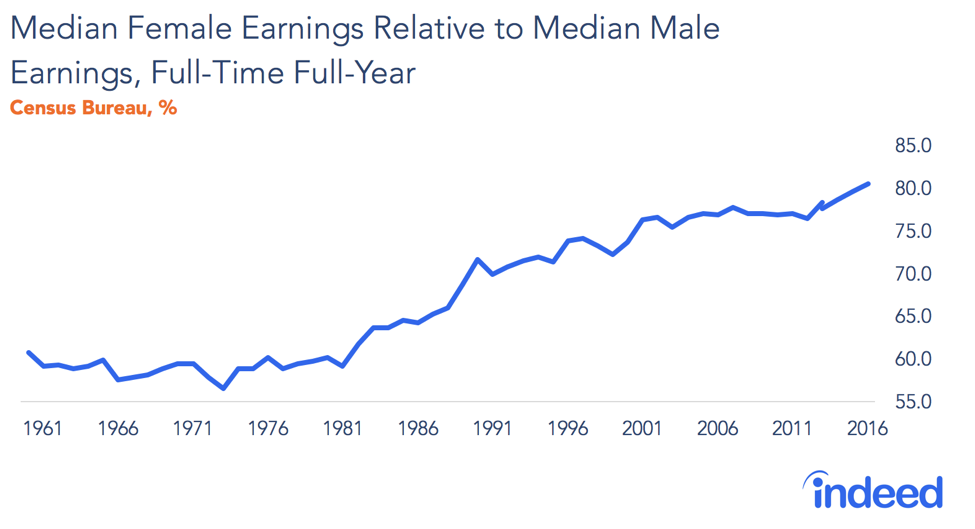Today is Equal Pay Day, the date marking how many extra days the median woman would have to work to equal what a man earns in a year. Despite significant economic progress over the past few decades, the typical woman still makes less than men. In 2016, the median man working full-time for a full year made $51,640, while the median woman made $41,554. That means she made about 80% of what he did, up from 58% in 1968. She would need to work around an additional three months to earn what he earned the previous year.
After changing little from 2002 to 2012, the pay gap has closed by three percentage points in recent years. This measure of the pay gap compares all women with all men. Accounting for racial differences, the median Black woman makes 62% of what the typical White man makes, while for Hispanic women, it’s an even lower 54%.
Indeed Hiring Lab provides a snapshot of the pay gap, the factors that may contribute to it, and the occupations in which women make the most and the least relative to men. Given that occupation and industry differences explain most of the pay gap, but also that men are more likely than women to work in occupations projected to shrink over the next decade, more equality in occupation and industry choices would help both men and women succeed economically.
Pay gap narrowing, but occupation still makes a difference
Occupation and industry are the largest drivers of the gender gap—51% according to one estimate. Of course, systemic barriers often discourage women from pursuing certain career paths. For example, higher-paying occupations may be more hostile to female workers or less willing to provide the flexibility that women may need to manage work and family. In addition, women face discrimination in the workplace, which may lead to receiving lower pay for similar work or not even being considered for some jobs.

While occupation and industry differences explain about 50% of the overall pay gap, disparities persist within occupations. In about 3% of occupations, including judicial law clerks and tour and travel guides, women actually earn more than their male counterparts. But in others, like financial specialists, or securities, commodities, and financial services agents, the pay gap is wider. In the finance, insurance and real estate industry, women make only 66% of what their male counterparts earn.

Men and the pay gap
Often overlooked in the closing of the pay gap is that it reflects in part a decrease in men’s real earnings. Men’s full-time full-year, inflation-adjusted earnings peaked in 1973 at $54,030. From 1973 to 2016, these earnings fell in real terms almost $2,400, while women’s earnings rose almost $11,000. That means almost 20% of the gender wage gap closure over this time frame is due to earnings losses for men. In fact, in almost half the years since 1968 where the gender wage gap closed, men’s earnings fell while women’s earnings rose.

This trend reflects an economy shifting toward occupations and skills that have traditionally been more female-dominated. As the Hiring Lab has noted, female-dominated jobs are projected to grow almost twice as fast as male-dominated jobs.
Why the pay gap persists
Of course, other factors besides occupation and industry—such as time in the labor force and family responsibilities like child-rearing and elder care—affect the pay gap. When education is accounted for, the pay gap actually widens because women tend to be more educated than men. The pay gap also grows in the mid-years of a woman’s career, possibly due in part to family responsibilities. Occupations such as pharmacist that allow for more flexible working hours see smaller pay gaps. In addition, women face discrimination in the workplace which can hold back their earnings.
The pay gap has persisted as women have dramatically increased their presence in the workforce. Women have made up around 47% of the labor force since 1999, up from 28% at the beginning of 1948. They also currently represent 49% of the college-educated labor force and 51% of the labor force for those with advanced degrees.
But things could change. If women and men were more equally distributed across all occupations, we would probably see improved outcomes for both men and women. The current distribution hurts women by contributing to the pay gap. But it also hurts men by shunting them into occupations projected to shrink over the next decade. Unless the underlying issues holding down the number of women in certain occupations and industries are addressed, women will continue to see less pay in their pockets than men. While changing the decisions workers make about occupations and industries is a difficult, long-term proposition, it is a crucial step for improving outcomes for both men and women.
Methodology
Unless otherwise noted, data is from the Census Historical Income tables. Note that there is a break in series in 2013, such that there are two observations for 2013. American Community Survey estimates are based on comparing the median wage of men and women in occupations with at least 100 observations for both men and women who worked 50 weeks or more in the year and had at least 35 usual hours per week.






